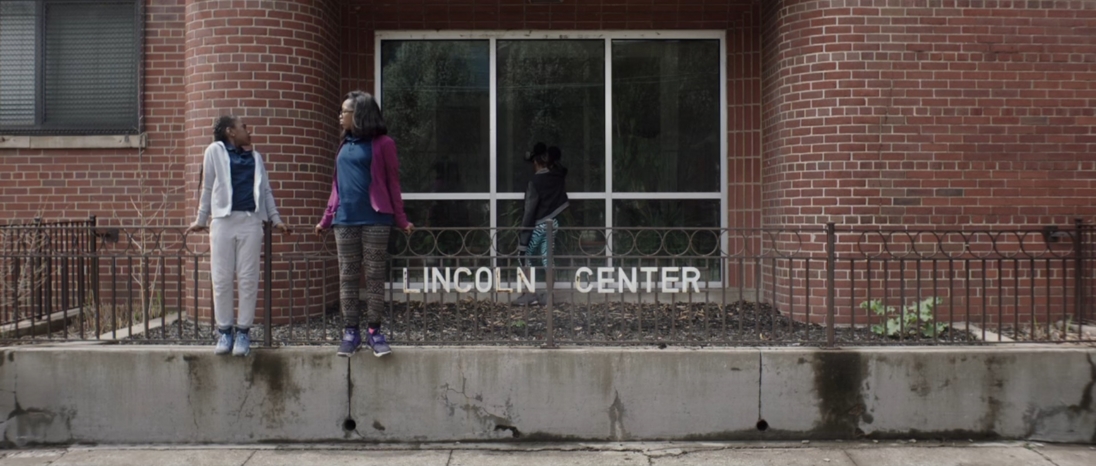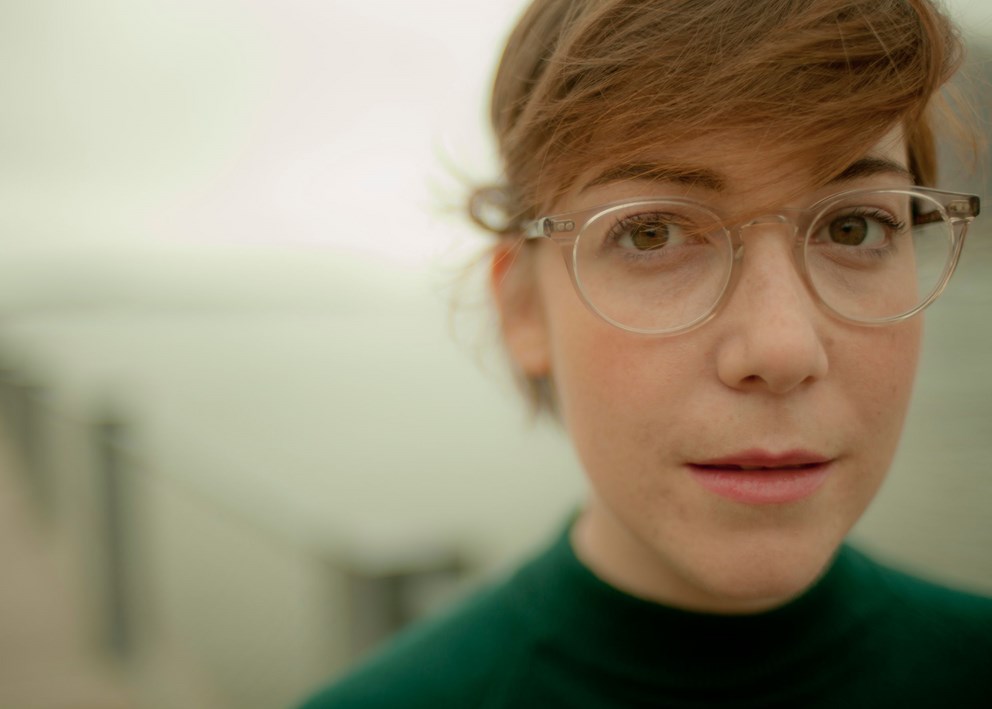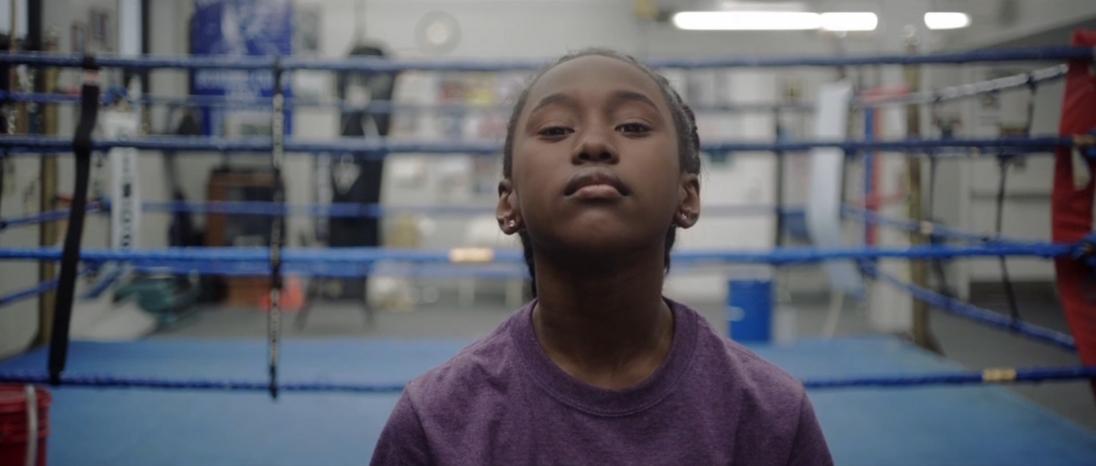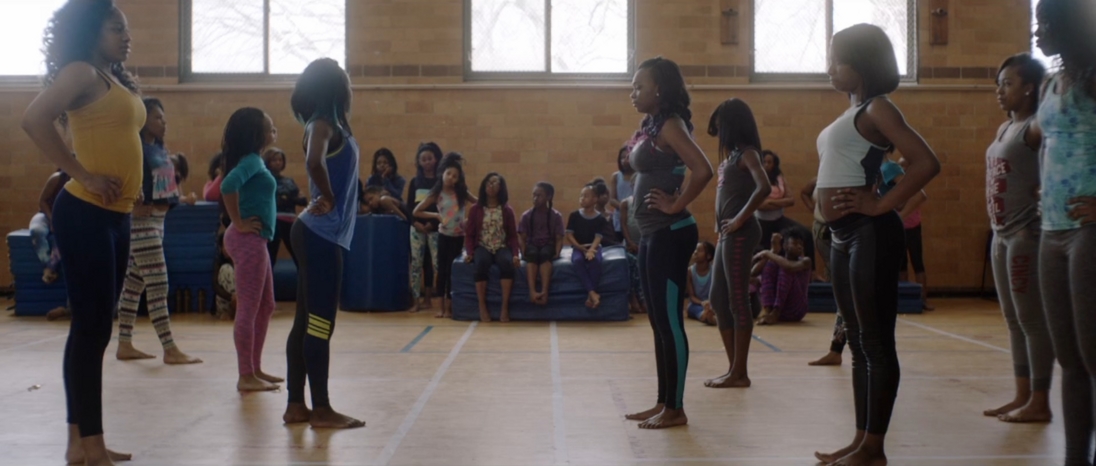“[Co-writers] Saela Davis, Lisa Kjerulff, and I all brought parts of ourselves to the writing process and Toni initially was a conglomerate of our identities at that age. At her core, Toni… has always been a complex blend of masculine and feminine, strong, independent, curious, proud and somehow unlike other 11-year-old girls we’d seen on screen before.”
The highly accomplished directorial debut of photographer-turned-filmmaker Anna Rose Holmer is a spirited and yet pensive film about biological rhythms and social conformity. The Fits, which has its Midwest premiere at the Wisconsin Film Festival at Sundance Cinemas on Apr 15 at 12:00p, intriguingly tackles the intimacy of a coming-of-age story through the restless, almost satirical lens of a medical thriller. With a predominantly adolescent cast at the Lincoln Community Center in Cincinnati’s West End, the energetic eleven-year-old Toni (Royalty Hightower) emerges as its star athlete, pulled between the emulation of two “gender impulses” (to quote Film Comment‘s Eric Hynes) in her brother’s sport of boxing and interpretive female dance group, The Lionesses, down the hall (populated by the actual Q-Kidz Dance Team).
In addition to intensive three-hour practices three days per week, Toni feels the progressive desire to fit in with the other girls, devoting off-hour time and effort to winning the approval of Lioness captains Legs (Makyla Burnam) and Karisma (Inayah Rodgers). But as mysterious convulsions begin to plague them during the routines, fear and speculation possess both the peripheral adults, who blame it on water contamination, as well as the aspiring youngsters, whose minds wander into something as far-fetched as a “boyfriend disease.” Strangely, these spasmodic “fits” soon become a sort of ritual of initiation for the girls, a sexual metaphor entangled with the realities of puberty and tension of social status. All seem to exclude Toni, the loner, who’s become a muscular role model for the younger Beezy (Alexis Neblett), the only one besides her brother Maine (Da’Sean Minor) who initially validates the purity of her presence.
In an interview with Holmer, we discussed shooting in the Cincinnati community, discovering the Q-Kidz and Queen City Boxing, collaborating with young actresses/actors, cinematic influences, and the intricacies of the film’s unique sound design:
In the first ten minutes of your film, I was reminded of Eliza Hittman’s It Felt Like Love, which harnesses a similar style, theme, and a tertiary plot around dance. But more specifically, I remember a direct comment from Hittman about her intention to realistically depict its setting (Brooklyn) rather than indulge in the kind of “hipster paradise” that so often appears in films made in New York. Did you also have this sort of goal in mind when you zeroed in on Cincinnati as the location for The Fits? What unforeseen benefits were there to working in the city? Would you say you were afforded accommodations a larger city wouldn’t have been able to provide? Your art assistant Sean Balanger is a friend of a friend (full disclosure); he and I talked briefly about the film scene in Cincinnati and how directors are able to transform/disguise the city as a larger one without much hassle, a benefit for some studio films. However, you intend not to mask location at all but rather subtly emphasize the character of the city (especially in early transitional shots) to inform the character of your film and the truths of these young women and men.
Anna Rose Holmer: We shot in Cincinnati because we cast the Q-Kidz Dance Team in our film and the reality of casting forty-five teenage girls is that you move your production to them. We also had the privilege of working with the Lincoln Community Center in the West End as our main location and hub during pre-production and production. Every location is within about 2,000 ft of the Community Center. The character of that building influenced the script and the final film. It has a beautiful lived-in sensibility and the cast was very comfortable there because that is the space where they actually practice on a daily basis. We could not have made the film without the support and generosity of the West End community and we are proud to show off those local spaces in the film. Working in Cincinnati was a very positive experience. Our team was a 50/50 mix of local crew and our crew from Brooklyn. It helped that both Carol and Miles Ahead had just wrapped there and the crew we found was hungry to work on an independent film and take creative reigns in their departments.
Along with Céline Sciamma’s Girlhood, The Fits is one of just a few recent films unquestionably receptive to the portrayal of black young women, who are underrepresented in cinema. Set in the Parisian suburbs, Girlhood may approach the journey from childhood to adulthood with a broader lens, but The Fits is more focused in its framing of a number of local performers and nonprofessional actresses. Firstly, could you talk about your attitude towards the representation of young women in the independent film scene and how The Fits fits into a larger narrative in this decade? Or do you feel like this argument exists solely outside your film?
ARH: It may surprise many viewers to hear that The Fits was not originally set in a drill community or with an all black cast. Those decisions came from discovering the Q-Kidz Dance Team early in the writing process and falling in love with drill as a dance form. Saela Davis, Lisa Kjerulff, and I all brought parts of ourselves to the writing process and Toni initially was a conglomerate of our identities at that age. At her core, Toni has always been a complex blend of masculine and feminine, strong, independent, curious, proud and somehow unlike other 11-year-old girls we’d seen on screen before. When we decided to set the film in a Cincinnati drill team, we adapted Toni to fit that world. And I would say Toni changed once more with Royalty Hightower’s influence on her as an actor. Unfortunately, there are not enough roles for young black girls in this industry, just as there are not enough roles for various voices outside of a narrow gaze. It is important to write diverse and distinctive roles for all types of girls where they lead the narrative, drive action, and live onscreen as complex human beings. It is equally important, as we found, to be open to discovering those roles through the writing process and embrace their significance.
In the film’s press kit, you mentioned finding the Q-Kidz Dance Team through a random YouTube recommendation. Could you elaborate further on their discovery and the general benefits of working with Royalty and real-life friends as opposed to a troupe of unacquainted teenagers?
ARH: From the film’s conception, I wanted to cast a real community of girls for the film. Casting all of the girls from the same real life drill team meant that we could emphasize the authentic sisterhood that young women experience when they bond on a team. There is this texture or underlying current that I knew we couldn’t pull off otherwise. So we knew when we approached the Q-Kidz that we were looking to cast not only a few of the leads, but really cast the entire team in our project. The founder of the Q-Kidz, Marquicia Jones-Woods, immediately understood the film and supported the vision. She was on board before the first draft of the script and worked closely with us as an Associate Producer. We also walked into a community that was centered around respect, hard work, creativity, and empowering these young women, and the benefits of working within that value system was immeasurable.
How was the experience with them different or comparable to the Queen City Boxing Club and the boxers like Da’Sean Minor and Antonio A.B. Grant Jr., who plays Donté?
ARH: Queen City Boxing, under the leadership of Sharon Rhodes and former pro boxer Frank Rhodes, was tremendously supportive with locations, casting, and the crucial boxing training for Royalty Hightower. Both Da’Sean Minor and Antonio A.B. Grant Jr. are ranked nationally at the Junior Olympic level. The thing to remember about all these kids is that they’re professional athletes who compete at the highest level. They are comfortable putting in the work at practice, managing expectations under pressure and engaging with adults and coaches on a daily basis. This may have been their first film shoot, but they were able to translate so many of their skills to the film world. They have self-discipline, which is a gift, and like the Q-Kidz, they just blew me away every day we were on set.
Also detailed in the press kit is your interest in long-form articles about the spread of mass hysteria/psychogenic illness, which became an inspiration for the kinetic development of the story, writing: “The majority of the episodes I learned about took place in tight-knit groups of girls with a strong hierarchical structure. I was also surprised that none of the cases ever seemed to be formally resolved or explained in any way.” As I read that, I thought immediately of Legs’ directive to the other girls: “Stop thinking like an individual, and start thinking like a team.” My cinematic mind jumped to Todd Haynes’ Safe and Jessica Hausner’s Amour Fou in which women are plagued by illnesses that are not properly diagnosed, treated, or placated. However, those two films are dedicated to the individual in static or slow-moving art house aesthetics where The Fits is about competitive contagion and decisive, liberating movement through every phase. The camera rarely is not moving, as it slow-pans around and closes in on Toni. Near its midpoint, the film briefly feels like it could even take a turn towards the epidemic mood of a medical thriller. Could you talk about the conflating of cinematic styles/tones? Or do your general influences stem mostly from the literary? How did you try to – and so successfully – balance/hybridize a tone that is at once real (documentary) and hyperreal (fiction) without purely yielding to one or the other?
ARH: From a stylistic point of view, I’ve always envisioned The Fits as a very formal exploration of cinematic tone and language. My cinematographer Paul Yee and I looked at a lot of horror and psychological thrillers as visual references, especially genre-blending films like Tomas Alfredson’s Let the Right One In. We also studied modern poetic films like Steve McQueen’s Hunger, that place a minimalist approach on narrative exposition to favor an audio-visual experience from a singular perspective. I think the balance of tone that you are reacting to most strongly comes from the influence of transcendental cinema, particularly the work of Bresson, where the mundane bleeds effortlessly into the profound.

Toni (Royalty Hightower), Maia (Lauren Gibson), and Beezy (Alexis Neblett). © Oscilloscope Laboratories
In a recent interview, I heard about the importance of Martin Bell and Mary Ellen Mark’s Streetwise, which is especially interesting considering its verité versus the stylized nature of The Fits. Is it a direct influence for the film, or has it been internalized at this point in your development as an artist?
ARH: Streetwise wasn’t a reference or a direct influence on The Fits. It was the first film I saw that made me want to be a filmmaker, specifically, it made me want to study cinematography. I came into film through photography and Mary Ellen Mark was my bridge between those worlds.
The winding chamber score by Danny Bensi and Saunder Jurriaans is hypnotically beautiful but also unsettling, reminiscent of the murmuring woodwinds and strings on their last compositions for Denis Villeneuve’s Enemy. In The Fits, a conscious attempt has been made to evoke or employ the circular-breathing technique (listeners may know if they’ve heard Colin Stetson’s solo saxophone-playing). The latter is most relevant, as the sound of the woodwind instruments undulate in rhythm with actual human breathing. If it’s not quite synesthesia, it’s at least psychologically compelling, because sonic environment feels inseparable from Toni’s experience and thus the film itself. How did you originally conceive the music? Did you first have a less experimental, more electro-pop/dance-oriented soundtrack (like Rye Rye) in mind?
ARH: We originally thought we might rely on more diegetic music, like the Rye Rye track. In the first assembly of the film, my editor Saela Davis and I had the same feeling about music. We wanted to use score to cue the audience into Toni’s internal state throughout the film. Danny and Saunder have scored some films in our friend group and they did the music for my producer Lisa Kjerulff’s documentary feature Northern Light which is directed by Nick Bentgen. Lisa sent them an early cut of The Fits and they connected with the film right away. We discussed using woodwinds in a non-traditional sense by including the sounds of the breath through the instruments, the vibrations of the reed and the sounds of the pads as they were played. Besides Colin Stetson, we also looked at work by Sam Newsome as a strong reference. The score was conceived to accent the internal turmoil that Toni’s body is undergoing throughout the film and to heighten this sense of quiet discomfort. We wanted to treat the instruments like bodies, and emphasize breath moving through the body. When Danny and Saunder brought the sound of clapping to the score, we all knew something magical was happening. They also worked very closely with our sound designer Chris Foster and that collaboration was very organic and fluid.
On the topic of sound design, could you speak a little about the challenges of micing the primary location of a gymnasium with so much reverb? Dialogue is occasionally difficult to hear in there, but I think that occasionally works to its advantage in creating Toni’s identity as an outcast, peering through door windows from the outside to ascertain things everyone else has already experienced.
ARH: Our sound designer Chris Foster and our production sound mixer Gillian Arthur met during the script phase to discuss strategy. Except for group screaming or shouting, we could get clean audio in the gymnasium without reverb, but Gil was always aware of how it was going to be used in the mix. We would record the reverb of the room as well, often in stereo, so we could use the surround elements of the room in the mix. We really loved Leslie Shatz’s work on films like Gus Van Sant’s Last Days or Kelly Reichardt’s Meek’s Cutoff, where you use sound design to further enforce the perspective of your protagonist. In this case, Toni is not privy to many conversations with the older girls or the adults, so the audience should not have greater access than she does to those moments.
At a taut 72 minutes, I left The Fits exhilarated with the desire to immediately watch it again. How much footage did you end up cutting from test screenings or earlier versions? After one viewing it seems like you trimmed as much as you could from the group dance scenes (including a wonderfully intriguing choice to have the captains of the dance team demonstrate the movements off-screen) to elevate the more intimate moments between Toni, Beezy, and Maia (Lauren Gibson).
ARH: We didn’t shoot much more than what is in the film. We cut out a few scraps and condensed some long takes into shorter segments, mostly just for pacing. We did add a few elements particularly to the friendship between Toni and Beezy during our two days of additional shooting late in the edit. Because my editor Saela Davis was one of our co-writers, we tried to keep the script lean and approach production with a “no-fat” mentality. As a micro-budget and micro-timeline production, these constraints were a reality. Between rough cut and locked picture, the real work was structurally rearranging to add punctuation and reinforce Toni’s POV throughout the entire film.
My favorite sequences feature an isolated Toni; in particular, there’s an eloquent bit near the midpoint where we see her running drills on the concrete overpass a second time without her brother. She throws down her boxing bag, does a set of jumping jacks, which flow into an uninhibited dance routine that incorporates boxing jabs. As the camera steadily zooms in, rhythmic clapping crescendos. It so perfectly articulates the dynamic of her inner self and emotional state, as both a dancer and a fighter, without a single word.
ARH: The overpass scene is my favorite as well because it’s really the story of Toni in a single shot. It’s a full page in the original script, with many physical and choreographic notes. The turning point in the action is described as: “A dancer blossoms before us.”
How long is the script? Did you have to rewrite some scenes to remove or alter significant dialogue as you filmed? Or were you fortunately able to instantly and naturally push the story along in collaboration with the talented young performers’ choreography?
ARH: The final script is 76 pages. Lisa, Saela, and I had a very detailed script going into production, but we always intended for the dialogue that we’d sketched in to change significantly through workshopping it with the actors. We filmed The Fits in an immersive environment, living on location and inviting the young cast to see themselves not just as performers, but as co-authors of the characters on screen. That meant that any suggestions they had were on the table. All of the actors took the dialogue and reworked in until they were comfortable with their lines and motivations. They also knew that so much of the dramatic action was not dependent on their dialogue and I think this helped relax everyone. The script is so detailed in its description of movement and choreography. We made sure that all of our story beats were fully developed within the actions the characters take, so any dialogue is simply reinforcing these moments. We’ve always seen this as a dance film from frame one to the closing credits, and so it was vital that the narrative weight of the film was placed on movement.
Thanks so much for your time. And congratulations on the upcoming theatrical release in June.
- Madison-area audiences can see The Fits on Fri, Apr 15 at 12:00p (Sundance Cinemas) and Sun, Apr 17 at 3:45p (UW Union South Marquee) as part of the eighteenth annual Wisconsin Film Festival.



